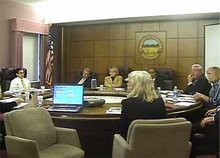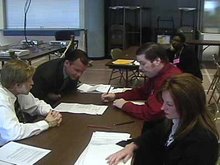Monday, December 3, 2007
Film: Some things (not everything,) you may want to know about ballot definition styles, ballot-on-demand, central count scanner hookups...and more...
Ballot definition styles, their data bases, and the correctness of accessing their data bases can make or break election results, all often with little knowledge of the voter. With DRE's for example, it is these files and their coding that determine what one's voter access card brings up on the screen as that person's ballot.
Does it contain all the races that person may vote upon or does it leave some candidates off? Or add too many? Could it be coded to make a vote for one person go to another? (It could, but with a printing paper trail, that too would also need to be manipulated, making one thing print and another thing recorded.) And more.
With Diebold-Premier at least, these files are created in the GEMS "mother-server," (in Cuyahoga, by Cuyahoga people, not Diebold-Premier. I understand though that in other counties, they may have their vendors, or with ES&S, vendor sub-contractors (!) create the ballot definition styles.)
And these files are used also for the counting in GEMS. (ie. This code, means this vote is cast for this person.) Therefore any mistakes in these files, intentional or otherwise, can wreak havoc to election results.
So I was curious about the subject in general, and about a few other things that I knew Matt Jaffe, head of the CCBOE Ballot Department might know about, so I asked him if he would let me interview him on camera, so I could share what I found out. He said yes!
I want to emphasize here, that I did NOT ask Matt to subject himself to this, because I suspected anything wrong! My intention was asking someone who might actually know, and would give me some straight answers. It's not an easy thing to do for BOE staffers.
My hat off to Matt, and my appreciation! (He did it, though he knows how suspect I am of the Diebold-Premier systems, and without knowing what I was going to ask him.)
(In fact, in this past election, there were about two or three cases where the ballot definition files had not been set to reflect a small township section, within a small outlying city's limits, which had their own school or council race - a rather unusual, detailed set up. But, when the problems were found, they were corrected on election day, via paper ballots, and/or after by accepting those paper provisional ballots. Also, the (I see as completely understandable, non-intentional) mistakes were forthrightly acknowledged, and they have been corrected in the ballot definition data base.)
So, on November 16, as the CCBOE was finishing preparing for the official count of the 11/6 election, exhausted Matt stayed late to allow me to interview him on camera to learn more about:
• some nuts and bolts of ballot definition files;
• about how central count scanners know what city and what race they're reading;
• about how our scanners are networked;
• about how much hands-on our Diebold Premier tech has into our system;
• about Ballot-on-Demand (something I DON'T like, as expressed in the interview)
• and more.
Also, you'll get to see Pat McDonald, our Deputy Director, who joined in "the fun" as he was leaving.
It was late. I could have been more prepared, and the film's a bit jumpy because of low computer RAM while processing it, but I think it's worth watching to learn a bit more about how it all works.
Does it contain all the races that person may vote upon or does it leave some candidates off? Or add too many? Could it be coded to make a vote for one person go to another? (It could, but with a printing paper trail, that too would also need to be manipulated, making one thing print and another thing recorded.) And more.
With Diebold-Premier at least, these files are created in the GEMS "mother-server," (in Cuyahoga, by Cuyahoga people, not Diebold-Premier. I understand though that in other counties, they may have their vendors, or with ES&S, vendor sub-contractors (!) create the ballot definition styles.)
And these files are used also for the counting in GEMS. (ie. This code, means this vote is cast for this person.) Therefore any mistakes in these files, intentional or otherwise, can wreak havoc to election results.
So I was curious about the subject in general, and about a few other things that I knew Matt Jaffe, head of the CCBOE Ballot Department might know about, so I asked him if he would let me interview him on camera, so I could share what I found out. He said yes!
I want to emphasize here, that I did NOT ask Matt to subject himself to this, because I suspected anything wrong! My intention was asking someone who might actually know, and would give me some straight answers. It's not an easy thing to do for BOE staffers.
My hat off to Matt, and my appreciation! (He did it, though he knows how suspect I am of the Diebold-Premier systems, and without knowing what I was going to ask him.)
(In fact, in this past election, there were about two or three cases where the ballot definition files had not been set to reflect a small township section, within a small outlying city's limits, which had their own school or council race - a rather unusual, detailed set up. But, when the problems were found, they were corrected on election day, via paper ballots, and/or after by accepting those paper provisional ballots. Also, the (I see as completely understandable, non-intentional) mistakes were forthrightly acknowledged, and they have been corrected in the ballot definition data base.)
So, on November 16, as the CCBOE was finishing preparing for the official count of the 11/6 election, exhausted Matt stayed late to allow me to interview him on camera to learn more about:
• some nuts and bolts of ballot definition files;
• about how central count scanners know what city and what race they're reading;
• about how our scanners are networked;
• about how much hands-on our Diebold Premier tech has into our system;
• about Ballot-on-Demand (something I DON'T like, as expressed in the interview)
• and more.
Also, you'll get to see Pat McDonald, our Deputy Director, who joined in "the fun" as he was leaving.
It was late. I could have been more prepared, and the film's a bit jumpy because of low computer RAM while processing it, but I think it's worth watching to learn a bit more about how it all works.
Subscribe to:
Post Comments (Atom)






1 comment:
Thank you Adele, and also the Cuyahoga BOE. I can think of almost no other BOE that would even answer these questions let alone on film.
I learned something and it's a good inquiry to make of other counties regarding Ballot on Demand.
Post a Comment